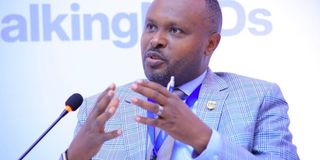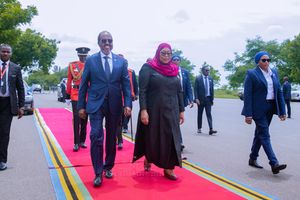SPECIAL REPORT: Gap EAC states must close to ensure universal healthcare

Medical Stores Department executive director Laurean Bwanakunu speaks during a dialogue on universal health coverage in Africa in Kampala Uganda. PHOTO | COURTESY
Dar es Salaam. Health experts from across East Africa have highlighted the importance of bridging the gap between public and private sectors as a strategy for attaining Universal Health Coverage (UHC).
Also known as ‘Universal Health Care,’ and ‘Socialised Health Care,’ UHC is a system that provides healthcare and financial protection to all citizens of a country.
The world is now driving a major campaign to ensure that every people — no matter who they are, where they live, or how much money they have, can access quality health services without suffering financial hardship. The aim is to achieve the vision by 2030. Much emphasis has also been placed on educating healthcare workers on screening patients to detect early signs of non-communicable diseases (NCDs) for prompt treatment.
In Tanzania, the focus is on enhancing universal health insurance (UHI) coverage among citizens.
That is being implemented by establishing health insurance schemes with affordable packages to cater for all the citizens.
In Tanzania, health insurance coverage is just above 30 per cent while Rwanda’s rate is over 90 per cent, with that of Ghana being over 60 per cent.
The government is striving to expand health insurance coverage to 50 per cent of all Tanzanians by 2020. However, this comes at a time when the government is shouldering the burden of over 70 per cent of people who receive healthcare by exemption. Speaking during dialogue on sustainable momentum towards universal health coverage in Africa in Kampala, the head of Novartis Social Business, Dr Harald Nusser, explained that the time had come for private and public sectors in healthcare to join hands in providing services so as to move steps ahead from where we are right now.
“This dream cannot be attained if every sector stands on its own,” explained Dr Nusser.
He hopes that will enable even the poor people and those in the informal sector to be released from the burden of paying from their pockets to cover for health.
“The poorest pay the most for healthcare. We need to expand coverage for access to health services up to the last person in the community.”
Moreover, explaining on the best possible means for financing healthcare coverage, the Amref Africa Group CEO, Dr Githinji Gitahi, said insurance-based packages were the best option because they enable groups to contribute.
According to him, the tax-based financing for healthcare that is adopted in the US is a bad option in Africa because more than half of public expenditure is financed through revenues other than earmarked payroll taxes.
Although African countries have improved in revenue collections -- ranging at between 17 and 18 per cent of their gross domestic product – there are inadequate to cover for healthcare of all citizens, said Dr Gitahi. That is why many African countries are adapting group insurance schemes, according to him.
That is mainly because almost 80 per cent of people are in the informal sector, making it hard to tax them but they do require health coverage.
“By adopting the group insurance scheme even those in the informal sector will be covered and this will reduce the use of out-of-pocket to cover healthcare, something that has been a struggle to many.”
He further explained that UHC is not a one night achievement but to be attained government should first start with the poor who are the most vulnerable so as to ensure equity.
“To achieve an A class society the government must first invest in the health of its people so as to ensure a disease free citizen and this will provide boost to business growth.”
Explaining on the issues regarding to NCDs which was the centre of discussion, Dr Gerald Mutungi, who heads the NCDs Desk at the Ministry of Health in Uganda, said that most Africans regard obesity as something of prestige and not a disease.
“In Uganda and most part of Africa, obesity is celebrated. You are looked at as rich and successful. People are given names like ‘Boss’ we also love driving, if it was possible, we would be driving to the toilet. We need to be more physically active like our forefathers.”
About a quarter of Ugandan adults have hypertension and are not aware that they do. Four per cent of Ugandans have diabetes while 80 per cent are unaware that they have the condition. Also, 40 per cent of mortality in Uganda is attributed to NCDs.
The National Institute for Medical Research previously worked with the government and the World Health Organisation in conducting studies, which revealed that the levels of risk factors for NCDs were high.
Findings revealed a high prevalence of diabetes (9.1 per cent) and hypertension (25.9 per cent).
WHO has projected those NCD deaths will increase globally between 2010 and 2020 from 36 to 44 million. The highest increase is projected to occur in Africa. In 2010, WHO released a report titled ‘Global status report on ‘Noncommunicable diseases: Description of the global burden of NCDs’, their risk factors and determinants’ that stated that the diseases were affecting 47 per cent of patients and that, out of the 100 that died, 60 died of NCDs.
These statistics show that if concerted action is not taken to fight the diseases by 2020, the statistics will go up from 47 to 60 per cent and the death rate will also shoot up from 60 to 73 per cent. Dr Mutungi calls for increased community sensitisation and early screening of individuals as something of a necessity, he further highlighted on the importance of capacity building at health facility and increased supplies and commodities.
Dr Diana Atwine, the permanent secretary in the Ministry of Health in Uganda, explained that partnership entails screening programmes, health promotion at the family level, empowerment of community health workers and strengthening community insurance programmes, a key success factor in healthcare financing.
She explained that building capacity and train healthcare workers at the national and community level with the aim of bringing health care closer to populations is a way forward.
“Nowadays whenever you visit the hospital with a headache you are given a malaria dosage but most of the time malaria is not the problem and you find yourself overtime taking medicines not intended for your sickness and that is why screening on NCDs is required to ensure early detection of the disease,” she said.
Medical Stores Department (MSD) executive director Laurean Bwanakunu said the Tanzania Food and Drugs Authority (TFDA) was doing a great job in ensuring that medicines that enter the country are of good quality and affordable.
Investing in health actually comes ahead of investment in infrastructure because when people have invested in health, they develop the economy.
Also, there is a need for leveraging digital technology to ensure access to quality healthcare.
Citizens are responsible for their health to achieve UHC as the government alone cannot do everything. Healthcare coverage requires individual responsibility, partnerships.
According to WHO, UHC means that all people and communities can use the promotive, preventive, curative, rehabilitative and palliative health services they need, of sufficient quality to be effective, while also ensuring that the use of these services does not expose the user to financial hardship. This definition of UHC embodies three related objectives:
Equity in access to health services - everyone who needs services should get them, not only those who can pay for them;
The quality of health services should be good enough to improve the health of those receiving services; and
People should be protected against financial-risk, ensuring that the cost of using services does not put people at risk of financial harm.




